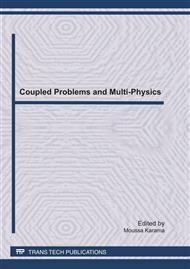[1]
S. Rossi, P.F. Luckham, S. Zhu, B.J. Briscoe and TH.F. Tadros. Influence of low molecular weight polymers on the rheology of bentonite suspensions. Revue de l'institut Français du pétrole, vol. 52, N°2 (1997).
DOI: 10.2516/ogst:1997019
Google Scholar
[2]
K. Bekkour, M. Leyama, A. Benchabane and O. Scrivener. Time dependent rheological behaviour of bentonite suspensions: An experimental study. J. Rheol., 49(6) (2005), 1329-1345.
DOI: 10.1122/1.2079267
Google Scholar
[3]
A. Allal, M. Gareche, J.C. Dupin, F. Roby et N. Zeraibi. Modélisation du module complexe de cisaillement des suspensions de bentonite. Rhéologie, Vol. 16 (2009), 35-44.
Google Scholar
[4]
P. Coussot, F. Bertrand, B. Herzhaft. Rheological Behavior of Drilling Muds, Characterization Using MRI Visualization. Oil & Gas Science and Technology – Rev. IFP, 59(1), 23-29 (2004).
DOI: 10.2516/ogst:2004003
Google Scholar
[5]
U. Cartalos, P. Baylocq, J. Lecourtier, J. -M. Piau. Caractérisation rhéologique et modélisation structurelle des systèmes argile-polymère application aux fluides de forage. Rev. IFP, 52 (3) (1997), 285-297.
DOI: 10.2516/ogst:1997041
Google Scholar
[6]
A. Almedar et N. Gungor. The rheological properties and characterization of bentonite dispersions in the presence of non ionic polymer PEG. J. of materials sci. 40 (2005), 171-177.
DOI: 10.1007/s10853-005-5703-4
Google Scholar
[7]
M. Benna, N. Kbir-Ariguib, A. Magnin et F. Bergaya. Effect of pH on rheological propreties of purified sodium bentonite suspensions. J. of col. and interface science. 218 (1999), 442-455.
DOI: 10.1006/jcis.1999.6420
Google Scholar
[8]
C.H. Manoratne et al. Ionic conductivity of polyethylene oxide (PEO) PEO-Montmorillonite (MMT) nanocomposites prepared by intercalation from aqueous medium. Int. J. Electrochem. Sci., 1 (2006), 32-46.
DOI: 10.20964/1010032
Google Scholar
[9]
S. Rossi, P.F. luckham, T. Tadros. Influence of non-ionic polymers on the rheological behaviour of Na+ -monmorillonite clay suspensions. Part II. Homopolymer ethyleneoxide and polypropylene oxide-polyethylene oxide ABA copolymers. Colloid and surfaces A: physicochem; Eng; Aspects 215 (2003).
DOI: 10.1016/s0927-7757(02)00446-6
Google Scholar
[10]
K.W. Ebagninin, A. Benchabane, et K. Bekkour. L'empreinte pont-polymère sur le comportement rhéologique des mélanges bentonite-PEO. 41 ème colloque du GFR, pp.271-274. Cherbourg, 18-20 octobre (2006).
Google Scholar
[11]
O. Ogata et al. Structure and thermal/mechanical properties of poly(ethylene oxide)-clay minerals blends. Polymer vol. 38, N° 20 (1997), pp.5115-5118.
DOI: 10.1016/s0032-3861(97)00055-4
Google Scholar
[12]
Z. Shen et al. Saturation ratio of poly(ethylene oxide) to silicate in melt intercalated nanocomposites. European polymer journal 39 (2003), 1917-(1924).
DOI: 10.1016/s0014-3057(03)00097-1
Google Scholar
[13]
Z. Shen et al. Comparison of solution intercalation and melt interaction of polymer-clay nanocomposites. Polymer 43 (2002), 4251-4260.
DOI: 10.1016/s0032-3861(02)00230-6
Google Scholar
[14]
J.M. Guzik, A. Pantet et P. Monnet. Etude des caractéristiques rhéologiques des suspensions de bentonite. Les cahiers de rhéologie, vol 13, n° 1-2 (1994), pg 150-159.
Google Scholar
[15]
N. Guven, Molecular aspects of clay-water interactions, C.M. S workshop lectures, volume 4 clay water interface and its rheological implication (1992), page 2-79.
DOI: 10.1346/cms-wls-4.1
Google Scholar
[16]
N. Guven. Rheological aspects of aqueous smectite suspensions. C.M. S workshop lectures, volume 4 clay water interface and its rheological implication (1992), page 81-125.
Google Scholar
[17]
N.J. Alderman, A. Gavignet, D. Guillot, G.C. Maitland. SPE 18035, 63 rd ANN. Tech. Conf. Houston, 1988, p.187.
Google Scholar
[18]
S. Rossi, P.F. luckham, T. Tadros. Colloids surf. A 201, 85 (2002).
Google Scholar
[19]
S. Rossi, P.F. luckham, N. Green, and T. Cosgrove. NMR solvent relaxation studies of Na+ montmorillonite clay suspensions containing non ionic polymers. Colloids and surf. A 215 (2003), 11-24.
DOI: 10.1016/s0927-7757(02)00447-8
Google Scholar
[20]
S. Rossi, P.F. luckham, T. Tadros. Influence of non-ionic polymers on the rheological behaviour of Na+-montmorillonite clay suspensions. Part II. Homopolymer ethyleneoxide and polypropylene oxide–polyethylene oxide ABA copolymers. Colloids surf. A 215 (2003).
DOI: 10.1016/s0927-7757(02)00446-6
Google Scholar
[21]
C.Y.M. Tung, and P. J. Dynes. Relationship between Viscoelastic System. J. Appl. Polm. Sci., 27 (1982), 569-574.
Google Scholar
[22]
P. Mongondry, T. Nicolai, and F. Tassin. Influence of pyrophosphate or polyethylene oxide on the aggregation and gelation of aqueous laponite dispersions. Journal of colloid and interface science, 275 (2004), 191-196.
DOI: 10.1016/j.jcis.2004.01.037
Google Scholar
[23]
J. Dau, and G. Lagaly. Surface modification of bentonites. II. Modification of montmorillonite with cationic poly(ethylene oxide). Croatica chemica acta, CCACAA 71 (4), (1998), 983-1004.
Google Scholar
[24]
A. Almedar, N. Gungor, O.I. Ece, & O. Atici. The rheological properties and characterization of bentonite dispersion in the presence of non-ionic polymer PEG. J. Mater. Sci. 40 (2005), 171-177.
DOI: 10.1007/s10853-005-5703-4
Google Scholar


